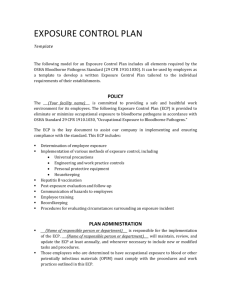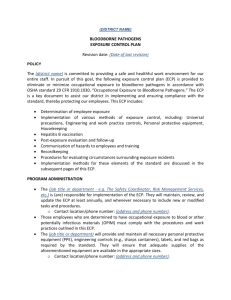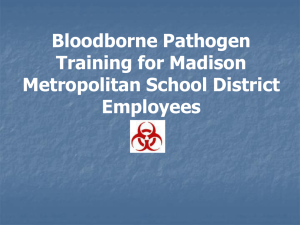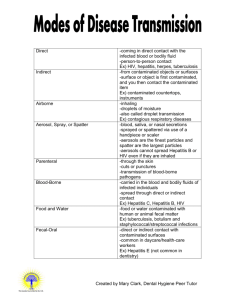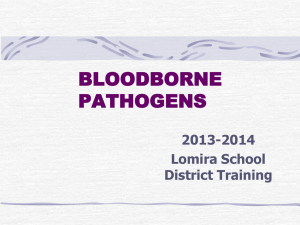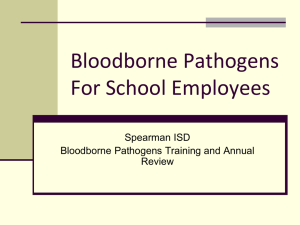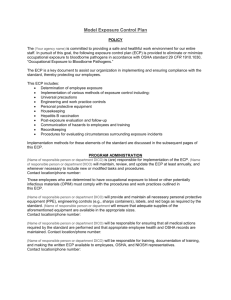Bloodborne Pathogen Standard Compliance Tool
advertisement
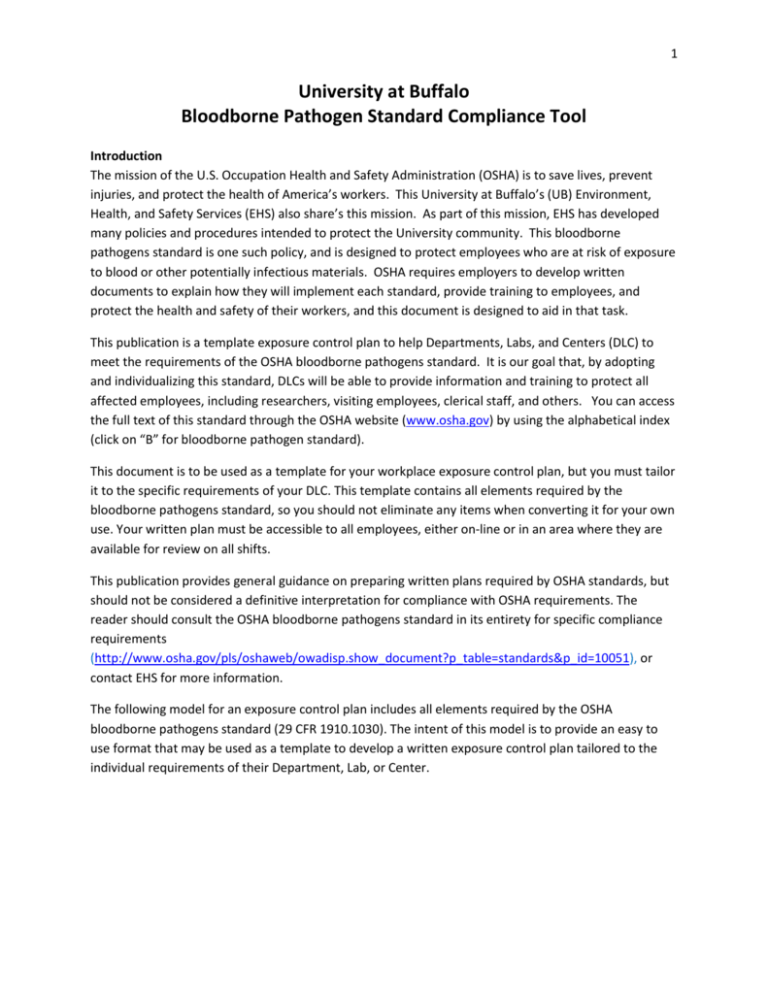
1 University at Buffalo Bloodborne Pathogen Standard Compliance Tool Introduction The mission of the U.S. Occupation Health and Safety Administration (OSHA) is to save lives, prevent injuries, and protect the health of America’s workers. This University at Buffalo’s (UB) Environment, Health, and Safety Services (EHS) also share’s this mission. As part of this mission, EHS has developed many policies and procedures intended to protect the University community. This bloodborne pathogens standard is one such policy, and is designed to protect employees who are at risk of exposure to blood or other potentially infectious materials. OSHA requires employers to develop written documents to explain how they will implement each standard, provide training to employees, and protect the health and safety of their workers, and this document is designed to aid in that task. This publication is a template exposure control plan to help Departments, Labs, and Centers (DLC) to meet the requirements of the OSHA bloodborne pathogens standard. It is our goal that, by adopting and individualizing this standard, DLCs will be able to provide information and training to protect all affected employees, including researchers, visiting employees, clerical staff, and others. You can access the full text of this standard through the OSHA website (www.osha.gov) by using the alphabetical index (click on “B” for bloodborne pathogen standard). This document is to be used as a template for your workplace exposure control plan, but you must tailor it to the specific requirements of your DLC. This template contains all elements required by the bloodborne pathogens standard, so you should not eliminate any items when converting it for your own use. Your written plan must be accessible to all employees, either on-line or in an area where they are available for review on all shifts. This publication provides general guidance on preparing written plans required by OSHA standards, but should not be considered a definitive interpretation for compliance with OSHA requirements. The reader should consult the OSHA bloodborne pathogens standard in its entirety for specific compliance requirements (http://www.osha.gov/pls/oshaweb/owadisp.show_document?p_table=standards&p_id=10051), or contact EHS for more information. The following model for an exposure control plan includes all elements required by the OSHA bloodborne pathogens standard (29 CFR 1910.1030). The intent of this model is to provide an easy to use format that may be used as a template to develop a written exposure control plan tailored to the individual requirements of their Department, Lab, or Center. 2 Model Exposure Plan: POLICY The University at Buffalo is committed to providing a safe and healthful work environment for our entire staff. In pursuit of this goal, the following exposure control plan (ECP) is provided to eliminate or minimize occupational exposure to bloodborne pathogens in accordance with OSHA standard 29 CFR 1910.1030, “Occupational Exposure to Bloodborne Pathogens.” The ECP is a key document to assist our organization in implementing and ensuring compliance with the standard, thereby protecting our employees. This ECP includes: Determination of employee exposure Implementation of various methods of exposure control, including: o Universal precautions o Engineering and work practice controls o Personal protective equipment o Housekeeping Hepatitis B vaccination Post exposure evaluation and follow up Communication of hazards to employees and training Recordkeeping Procedures for evaluating circumstances surrounding exposure incidents Implementation methods for these elements of the standard are discussed in the subsequent pages of this ECP. PROGRAM ADMINISTRATION (name of responsible person or department) is (are) responsible for implementation of the ECP. (Name responsible person or department) will maintain, review, and update the ECP at least annually, and whenever necessary to include new or modified tasks and procedures. Contact location/phone number:_____________ Those employees who are determined to have occupational exposure to blood or other potentially infectious materials (OPIM) must comply with the procedures and work practices outlined in the ECP. (name of responsible person or department) will provide and maintain all necessary personal protective equipment (PPE), engineering controls (e.g., sharp containers), labels, and red bags as required by the standard. (Name of responsible person or department) will ensure that adequate supplies of the aforementioned equipment are available in the appropriate sizes. Contact location/phone number:______________ (name of responsible person or department) will be responsible for ensuring that all medical actions required by the standard are preformed and that appropriate employee health and OSHA records are maintained. Contact location/phone number: _______________ 3 (name of responsible person or department) will be responsible for training, documentation of training, and making the written ECP available to employees, OSHA and NIOSH representatives. Contact location/phone number: ___________________ EMPLOYEE EXPOSURE DETERMINATION: The following are examples of job classifications in which some employees at UB may have occupational exposure. Professor Resident Research Scientist Academic Physician Registered Nurse Clinical Researcher Research Technician Principal Investigator Research Assistant Psychiatrist Law Enforcement Clinical Professor Clinical Instructor Project Manager Physician Nurse Practitioner Physician Assistant Hospital Attendant Clinic Manager Immunization Coordinator Medical Technologist Research Support Specialist Laboratory Technician Post Doctoral Fellow METHODS OF IMPLEMENTATION AND CONTROL Universal Precautions All employees will utilize universal precautions, which refers to the practice of avoiding contact with human bodily fluids by means of the wearing of personal protective equipment such as medical gloves, eye protection, and/or face shields as necessary when contact is anticipated. Exposure Control Plan Employees covered by the bloodborne pathogens standard shall receive an explanation of the ECP during their initial training session. It will also be reviewed in their annual refresher training. All employees can review this plan at any time during their work shifts by contacting (name of responsible person or department). (name of responsible person or department) is responsible for reviewing and updating the ECP annually or more frequently if necessary to reflect any new or modified tasks and procedures that affect occupational exposure and to reflect new or revised employee positions with occupational exposure. 4 Engineering Controls and Work Practices Engineering controls and work practice controls will be used to prevent or minimize exposure to bloodborne pathogens. The specific engineering controls and work practices controls used are listed below (List those items specific to your Department, Lab, or Center): (for example: non-glass capillary tubes, sharps with engineered sharps injury protections (SESUIP), and needleless systems) Sharps disposal containers are inspected and maintained or replaced by (named of responsible person or department) whenever necessary to prevent overfilling. This facility identifies the need for changes in engineering controls and work practices through (examples: employee interviews, committee activities, changes in research, etc.) We evaluate new procedures and new products regularly by (describe process, examples include literature reviewed, supplier info, products considered) Principal Investigators, researchers, and other faculty and staff are involved in this process in the following manner: (describe employees’ involvement) (name of responsible person department) is responsible for ensuring that these recommendations are implemented. Personal Protective Equipment (PPE) PPE is provided by (Department, Lab or Center) to its employees at no cost to them. Training in the use of the appropriate PPE for specific tasks of procedures is provided by (name of responsible person or department). The types of PPE available to employees are as follows: (list those items available by your DLC. Examples include: gloves, eye protection, etc.) PPE is available from (location and responsible person) and may be obtained by (specify how employees will obtain PPE) Wear appropriate gloves when it is reasonably anticipated that there may be hand contact with blood or other potentially infectious materials (OPIM), and when handling or touching contaminated items or surfaces; replace gloves if torn, punctures, or contaminated, or it their ability to function as a barrier is compromised. Utility gloves may be decontaminated for reuse if their integrity is not compromised; discard utility gloves if they show sign s of cracking, peeling, tearing, puncturing, or deterioration. Never wash or decontaminate disposable gloves for reuse. Wear appropriate face and eye protection when splashed, sprays, spattered, or droplets of blood or OPIM pose a hazard to eye, nose, or mouth. Remove immediately or as soon as feasible any garment contaminated by blood or OPIM, in such a way as to avoid contact with the outer surface. 5 All employees using PPE must observe the following precautions: Wash hands immediately or as soon as feasible after removing gloves or other PPE Remove PPE after is becomes contaminated and before leaving the work area. Used PPE may be placed in (list appropriate containers for storage, laundering, decontamination, or disposal.) The procedure for handling used PPE is as follows: (detail procedures here or you may refer to a specific procedure by title or number and last date of review; include how and where to decontaminate face shields, eye protection, and resuscitation equipment if necessary) Housekeeping Regulated medical waste is generally defined by New York State’s Department of Environmental of Conservation as a waste that is capable of transmitting disease to humans. This waste is further defined as that generated in the diagnosis, treatment or immunization of human beings or animals, in research pertaining thereto, or in production and testing of biologicals. Additionally, regulated medical waste (RMW) cannot contain any hazardous chemical or radioactive waste components) shall be placed in containers which are closable, constructed to contain all contents and leakage, are appropriately labeled or color coded (see the following section “labels”), and closed prior to removal to prevent spillage or protrusion of contents during handling. The procedure for handling sharps disposal containers is: (outline procedures here or refer to specific to procedure by title or number and last date of review) The procedure for handling other regulated waste is: (outline procedures here or refer to specific procedure by title or number and last date of review) Contaminated sharps are discarded immediately or as soon as possible in containers that are closable, puncture-resistant, leak proof on sides and bottoms, and appropriately labeled or color-coded. Sharps disposal containers are available at (identify location). Bins and pails (e.g., wash or emesis basins) are cleaned and decontaminated as soon as feasible after visible contamination. Broken glassware that may be contaminated is only picked up using mechanical means, such as a brush and dustpan. Laundry (Complete this section if laundry service is used for contaminated clothing. Delete this section if not.) The following contaminated article will be laundered by (identify laundry service): (identify articles that are laundered by this service) 6 The following laundering requirements must be met: Handle contaminated laundering as little as possible, with minimal agitation Place wet contaminated laundry in leak-proof, labeled or color-coded containers before transport. Use (specify the specific laundry container) for this purpose. Wear the following PPE when handling and/or sorting contaminated laundry: (list appropriate PPE) (Complete this section for individuals who launder their own clothes) The following laundering requirements should be met: Remove any contaminated clothing prior to leaving work and secure in a plastic bag or similarly impervious container. Handle any potentially contaminated laundering as little as possible, with minimal agitation Wash any contaminated clothing by itself in hot water. Inspect clothing following washing cycle for any evidence of residual contamination (i.e. staining) and repeat as necessary. Labels The following labeling methods are used in this facility: Equipment to be labeled Label type (size, color, symbol) (Identify all equipment and containers that require labeling and the label type) (name of responsible person or department) is responsible for ensuring that warning labels are affixed or red bags are used as required if regulated waste or contaminated equipment is brought into the facility. Employees are to notify (name of responsible person or department) if they discover regulated waste containers, refrigerators containing blood or OPIM, contaminated equipment, etc, without proper labels. HEPATITIS B VACCINATION (name of responsible person or department) will provide training to employees on hepatitis B vaccinations, addressing safety, benefits, efficacy, methods of administration, and availability. The hepatitis B vaccination series is available at no cost after initial employee training and within 10 days of initial assignment to all employees identified in the exposure determination section of this plan. Vaccination is encouraged unless: 1) documentation exists that the employee has previously received the series; 2) antibody testing reveals that the employee is immune; or 3) medical evaluation shows that the employee has a condition or factor that serves as a reason to withhold the vaccination. However, if an employee declines the vaccination, the employee must sign a declination form (see attached Hepatitis B Vaccine Acceptance/Declination Forms). Employees who decline may request and 7 obtain the vaccination at a later date at no cost. Documentation of refusal of the vaccination is kept at (list location). Vaccination will be provided by (list health care professional and/or medical facility responsible for this part of the plan). Following the medical evaluation, a copy of the health care professional’s written opinion will be obtained and provided to the employee within 15 days of the completion of the evaluation. It will be limited to whether the employee requires the hepatitis vaccination and whether the vaccine was administered. POST-EXPOSURE EVELUATION AND FOLLOW-UP Should an exposure incident occur, contact (name of responsible person(s)) at the following number: (list number or numbers here) An immediately available confidential medical evaluation and follow-up will be conducted by (name of licensed health care professional or facility, while EHS cannot formally recommend any one entity or individual, as of June 2011, Millard Fillmore Suburban and ECMC are offered as suggestions. Please ensure that your facility of choice is notified prior to finalizing their cooperation.). Following initial first aid (clean wound, flush eyes or other mucous membrane, etc.), the following activities will be preformed: Document the routes of exposure and how the exposure occurred. Identify and document the source individual (unless it can be established that the identification is infeasible of prohibited by state or local law). Obtain consent and make arrangement to have the source individual tested as soon as possible to determine HIV, HCV, and HBV infectivity; document that the source individual’s test results were conveyed to the employee’s health care provider. If the source individual is already known to be HIV, HCV and/or HBV positive, new testing need not be preformed. Assure that the exposed employee is provided with the source individual test results and with information about applicable disclosure laws and regulations concerning the identity and infectious status of the source individual (e.g., laws protecting confidentiality). After obtaining consent, collect exposed employee’s blood as soon as feasible after exposure incident, and test blood for HBV and HIV serological status. If the employee does not give consent for HIV serological testing during collection of blood for baseline testing, preserve the baseline blood sample for at least 90 days; if the exposed employee elects to have the baseline sample tested during the waiting period, perform testing as soon as feasible. ADMINISTRATION OF POST-EXPOSURE EVALUATION AND FOLLOW-UP (name of responsible person or department) ensures that health care professional(s) responsible for employee’s hepatitis B vaccination and post evaluation and follow-up are given a copy of OSHA’s Bloodborne pathogens standard, and the DLC’s ECP. 8 (name of responsible person or department) ensures that the health care professional evaluating an employee after an exposure incident receives the following: A description of the employee’s job duties relevant to the exposure incident Route(s) of exposure Circumstance of exposure If possible, results of the source individual’s blood test Relevant employee medical records, including vaccination status (name of responsible person or department) provides the employee with a copy of the evaluating health care professional’s written opinion within 15 days after completion of the evaluation PROCEDURES FOR EVALUATING THE CIRCUMSTANCES SURROUNDING AN EXPOSURE INCIDENT (name of responsible person or department) will review the circumstances of all exposure incidents to determine: Engineering controls in use at the time Work practices followed A description of the device being used (including type and brand) Protective equipment of clothing that was used at the time of the exposure incident (gloves, eye shields, etc.) Location of the incident (laboratory, operatory, clinic, patient room, etc.) Procedure being performed when the incident occurred Employee’s training (Name of responsible person – EHS recommends DLCs contact their Human Resources representative to identify and assign this person) will record all percutaneous injuries from contaminated sharps in a Sharps Injury Log. If revisions in this ECP are necessary (responsible person or department) will ensure that appropriate changes are made (changes may include the evaluation of safer devices , adding employees to the exposure determination list, etc.) EMPLOYEE TRAINING All employees who have occupational exposure to bloodborne pathogens receive initial and annual training conducted by (name of responsible person, department, or facility, including a brief description of their qualifications). All employees who have occupational exposure to bloodborne pathogens receive training on the epidemiology symptoms, and transmission of bloodborne pathogen diseases. In addition, the training program covers, at a minimum, the following elements: A copy and explanation of the OSHA bloodborne pathogen standard 9 And explanation of our ECP and how to obtain a copy And explanation of methods to recognize tasks, and other activities that may involve exposure to blood and OPIM, including what constitutes an exposure incident An explanation of the use and limitations of engineering controls, work practices, and PPE An explanation of the types, uses, location, removal, handling, decontamination, and disposal of PPE An explanation of the basis for PPE selection Information on the hepatitis B vaccination, including information on its efficacy, safety, method of administration, the benefits of being vaccinated, and that the vaccination will be offered free of charge Information on the appropriate action to take and person to contact in an emergency involving blood or OPIM An explanation of the procedure to follow if an exposure incident occurs, including the method of reporting the incident and the medical follow-up that will be made available Information on the post-exposure evaluation and the follow up that the employer is required to provide for the employee following an exposure incident And explanation of the signs and labels and/or color coding required by the standard and used at this facility An opportunity for interactive questions and answer with the person conducting the training session. Training materials for this facility are available at (name location) RECORD KEEPING Training Records Training records are completed for each employee upon completion of training. These documents will be kept for at least three years at (location of records). The training records include: The dates of the training sessions The contents of a summary of the training sessions The names and qualifications of persons conducting the training The names and jobs titles of all persons attending the training sessions Employee training records are provided upon request to the employee or the employee authorized representative within 15 working days. Such requests should be addressed to (name of responsible person or department) MEDICAL RECORDS Medical records are maintained for each employee with occupational exposure in accordance with 29 CFR 1910.1020, “Access to Employee Exposure and Medical Records.” 10 (name of responsible person or department – EHS recommends that individual DLCs contact their Human Resources representative to identify and assign this person) is responsible for maintenance of the required medical records. These confidential records are kept in (list location) for at least the duration of employment plus 30 years. Employee medical records are provided upon request of the employee or to anyone having written consent of the employee within 15 working days. Such requests are sent to (name of responsible person of department and address). OSHA Recordkeeping An exposure incident is evaluated to determine if the case meets OSHA’s recording requirement (29 CFR 1904). This determination and the recording activities are done by (name of responsible person or department). Sharps injury log In addition to the OSHA 1904 Recordkeeping Requirements, all percutaneous injuries from contaminated sharps are also recorded in a Sharps Injury Log (EHS recommends each individual DLC contact their Human Resources representative to resolve log responsibilities). All incidents must include at least: Date of injury Type and brand of the device involved (syringe, suture needle) Department or work area where the incident occurred Explanation of how the incident occurred This log is reviewed as part of the annual program evaluation and maintained for at least five years following the end of the calendar year covered. If a copy is requested by anyone, it must have any personal identifiers removed from the report. 11 Attachment - Hepatitis B Vaccine Acceptance/Declination Forms HEPATITIS B VACCINE DECLINATION (MANDATORY) Include one of the following declination forms in an employee’s records if they refuse Hepatitis B vaccination: I understand that due to my occupational exposure to blood or other potentially infectious materials I may be at risk of acquiring hepatitis B virus (HBV) infection. I have been given the opportunity to be vaccinated with hepatitis B vaccination, at no charge to myself. However, I decline the hepatitis B vaccination at this time. I understand that by declining the vaccine, I continue to be at risk of acquiring hepatitis B, a serious disease. If in the future I continue to have occupational exposure to blood or other potentially infectious materials and I want to be vaccinated with hepatitis B vaccine, I can receive the vaccination series at no charge to me. Signed: (Employee name) Date: Or: HEPATITIS B VACCINE ACCEPTANCE/DECLINATION FORM ACCEPTANCE: I understand that due to my occupational exposure to blood or other potentially infectious materials I may be at risk of being infected by bloodborne pathogens, including Human Immunodeficiency Virus (HIV) and Hepatitis B Virus (HBV). This is to certify that I have been informed about the symptoms and the hazards associated with these viruses, as well as the modes of transmission of bloodborne pathogens. I have been given the opportunity to be vaccinated with Hepatitis B vaccine, at no charge to myself. In addition, I have received information regarding the Hepatitis B (HBV) vaccine. Based on the training I have received, I am making an informed decision to accept the Hepatitis B (HBV) vaccine. DECLINATION: I understand that due to my occupational exposure to blood or other potentially infectious materials I may be at risk of acquiring Hepatitis B virus (HBV) infection. I have been given the opportunity to be vaccinated with hepatitis B vaccine, at no charge to myself. However, I decline Hepatitis B vaccination at this time. I understand that by declining this vaccine, I continue to be at risk of acquiring Hepatitis B, a serious disease. If in the future I continue to have occupational exposure to blood or other potentially infectious materials and I want to be vaccinated with Hepatitis B vaccine, I can receive the vaccination series at no charge to me. CHECK ONE: _____ I ACCEPT Hepatitis B vaccine inoculation OR _____ I DECLINE Hepatitis B vaccine inoculation. ____________________________ Employee's Name ____________________________ _______________ Employee's Signature Date ____________________________ _______________ Witness Signature Date
